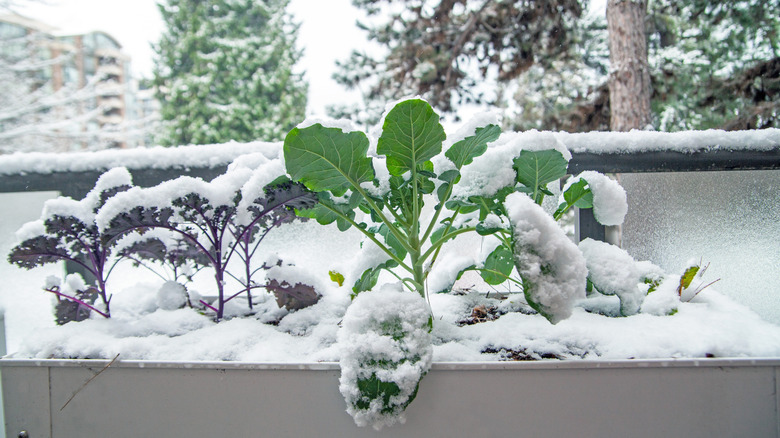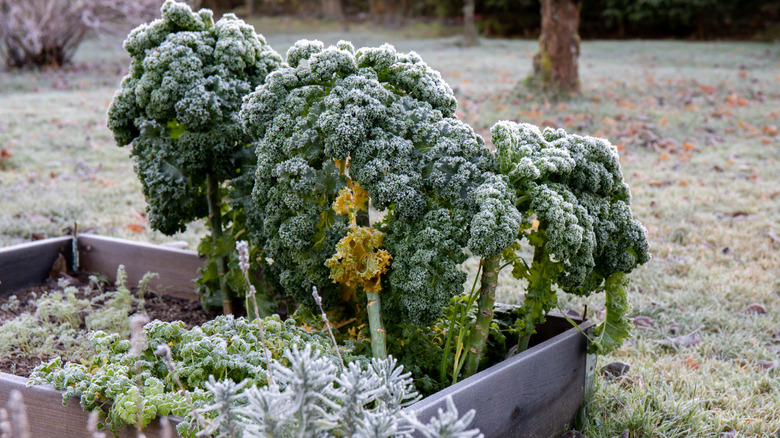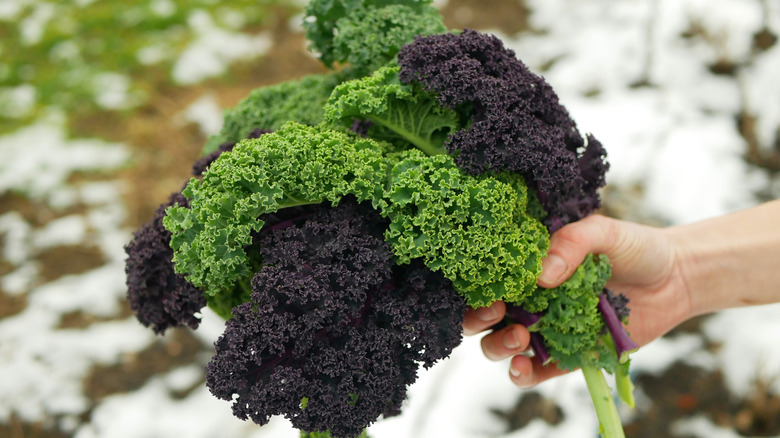Bitter Greens Might Be The Solution To Your Empty Winter Garden
For many gardeners who live in colder growing zones, winter is a time of planning what to grow and dreaming of spring blooms. Like other gardeners, I spend a lot of time in winter perusing garden catalogs to lift my spirits on cold winter days. But for those who'd like to try growing some food in winter, there are a few edible plants that can handle cold temperatures and even snowfall. If your empty winter garden makes you eager for growing season, planting some bitter greens may be a good solution.
Bitter greens refers to a range of greens including kale (Brassica oleracea), spinach (Spinacia oleracea), and arugula (Eruca vesicaria), among others. These greens are known for having a somewhat bitter taste, although many of them also have mild and even sweet flavor notes. In fact, some so-called bitter greens develop more sweetness after a hard frost. This is because some greens produce more sugars when exposed to cold temperatures, which changes their physical structure and protects them from further damage while also producing a sweeter flavor. This common phenomenon can be observed in kale after a hard frost.
Growing greens in winter does require some specific tricks and a bit of effort, but it is well worth it. The key to growing these annual vegetables in winter is to make sure they are well-established before it gets too cold. This gives them a better chance of surviving hard frosts and freezing. There a few tips that can help you, including knowing what kinds of greens to plant and when and how to protect your vegetable garden from freezing when temperatures plummet.
Which bitter greens to grow in winter
I've grown various types of spinach, kale, lettuces, and arugula that have continued to produce after frost. I consider these tasty, nutritious greens a real gift from the garden after the late summer harvest season has ended. In my experience, many varieties of kale start to get much more flavorful after the first hard frost. There are basically three kinds of kale defined by their leaf shapes: curly kale, blade-shaped lacinato (or "dinosaur") kale, and flat-leafed kale, which includes the Russian and Siberian varieties. Red Russian kale and curly kale (try 'Winterbor' or 'Redbor') both do very well in the cold. Plant kale from seed in September after temperatures have cooled.
Spinach is another bitter green that can survive frost. It germinates at 39 degrees Fahrenheit, so sow the seeds while night time temperatures are still somewhat mild. Plant cold-hardy varieties like 'Giant Winter' and 'Winter Bloomsdale.' Arugula is also very cold hardy and most varieties will produce well if planted for a late-season crop. Arugula has very shallow roots and so is easy to grow in containers for a winter harvest. Try 'Sylvetta' (a wild variety), 'Bellezia,' or 'Ice Bred.'
Preventing lettuce from bolting in warm weather is something many gardeners struggle with from time to time, but many lettuces are cold hardy. Despite lettuce seeming like a summer-grown vegetable, it's worth planting lettuce for winter harvest. Romaine lettuces are the most cold hardy. A late-season crop planted after the hottest part of summer will provide lettuce as temperatures drop. Try 'Rouge D'Hiver' for a ruffly red-tinged Romaine lettuce, or 'Winter Density' (a romaine/butterhead hybrid).
Keeping bitter greens growing after frost
Clients often ask me if they should put their entire vegetable garden to bed in the fall. In most cases, this is a good idea, and it saves time in spring when there are many other garden chores to do. However, if they have greens already established, I encourage them to keep harvesting as long as they're able. A bit of winter protection is helpful and there are several ways to do this.
Putting a bit of straw around the base of the plants is not only a good method for preventing summer weeds; it can also protect the roots and prevent the soil from freezing too quickly in winter. You can also cover your greens to protect them. You can buy special row cover fabric or use a sheet or blanket, but do not use plastic, which can trap moisture against leaves and make matters worse. You can even keep your greens from freezing in winter by building a clever hoop house.
Another thing to keep in mind is not to harvest too much from the plant at one time, especially if hard frost is in the forecast. This can leave the plant somewhat vulnerable to cold. Harvest only what you need for each meal, and the plant will happily keep growing just like it does in summer. If it looks like a long stretch of very cold weather is coming, you may want to harvest the more tender plants, like lettuce, to use up while you can. Sturdier greens like spinach, arugula, or kale can be blanched and frozen or used to make pesto.


